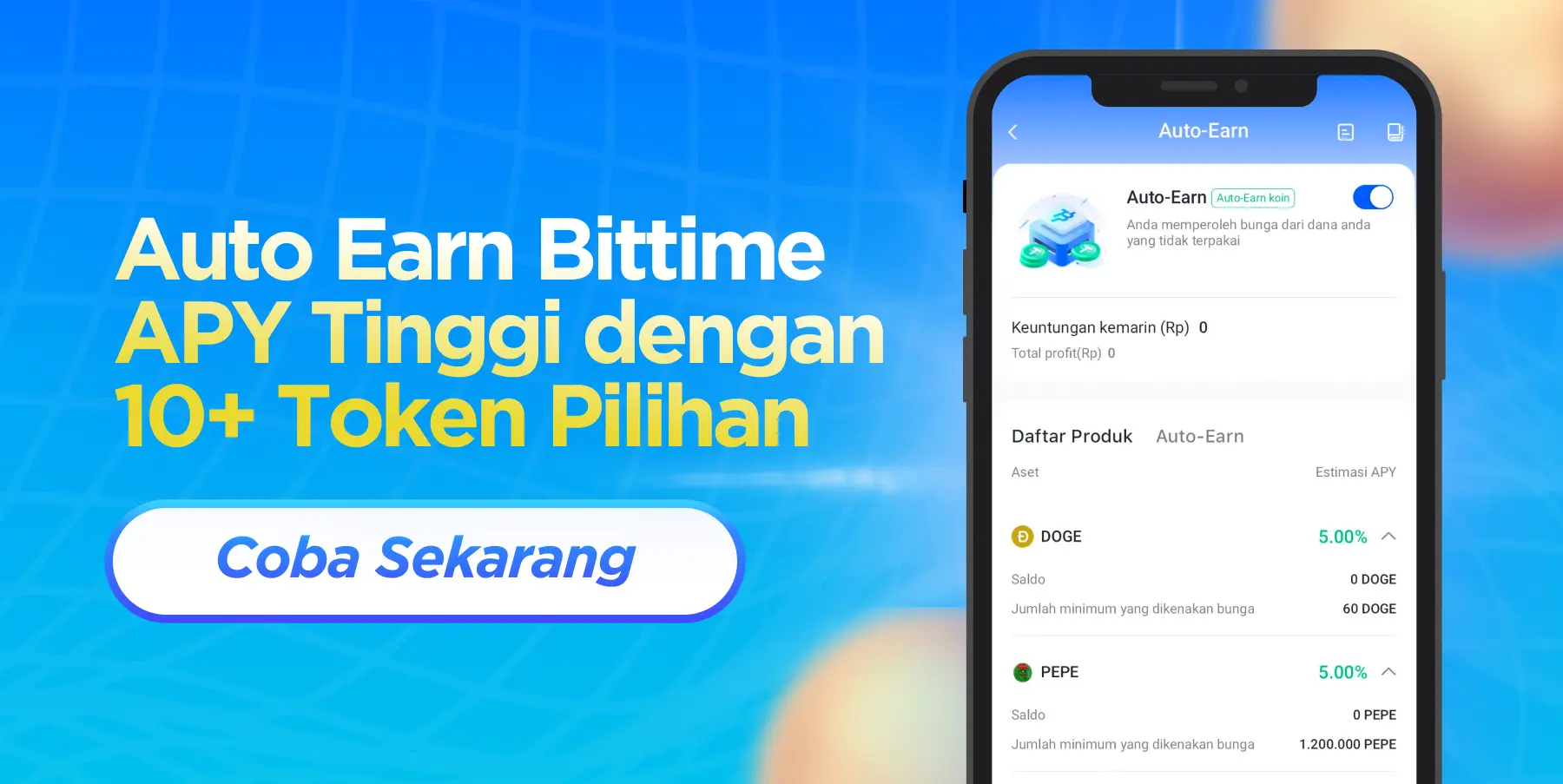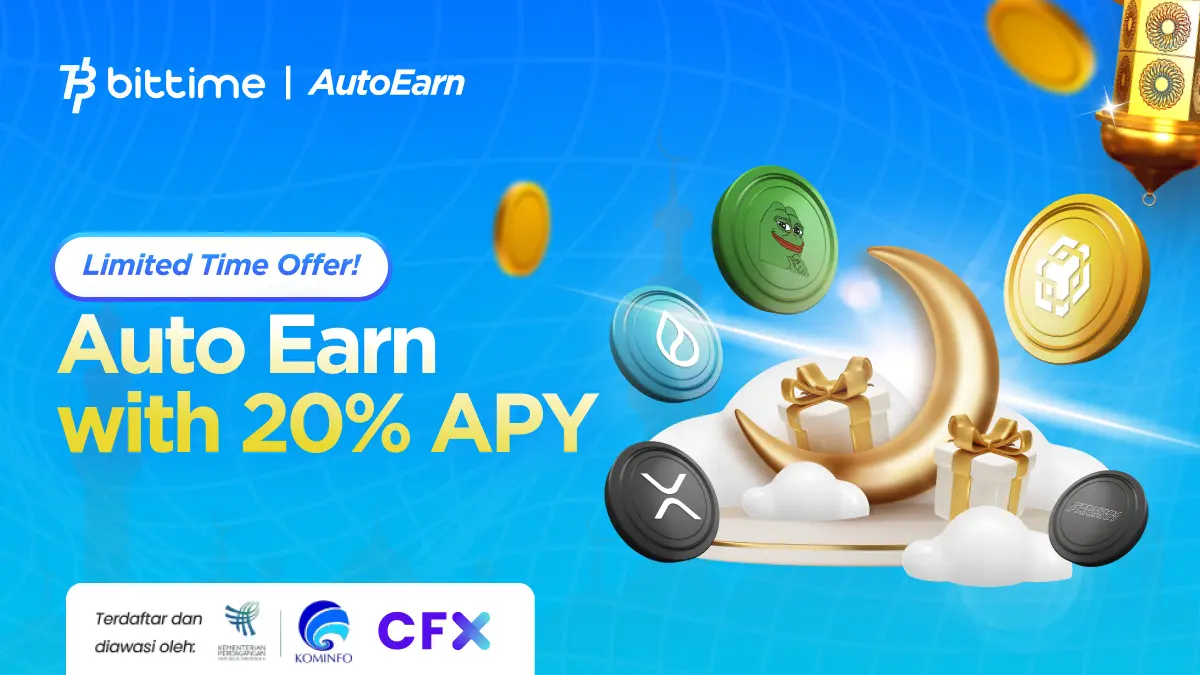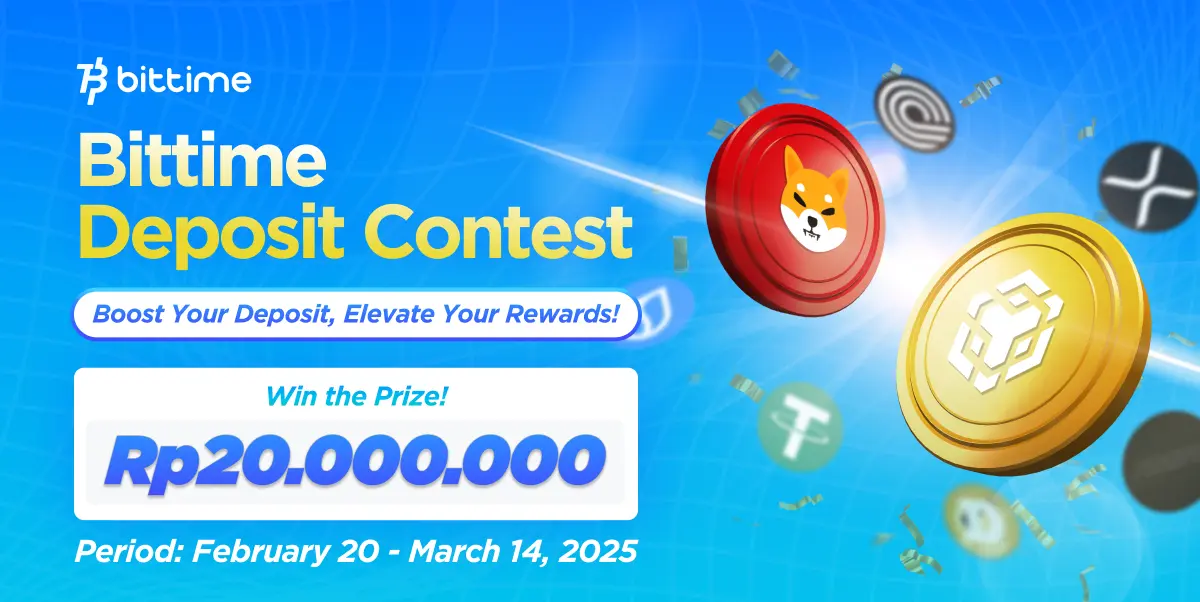List of Top 15 Layer-2 Blockchains that are the Best Solutions in 2025
2025-03-06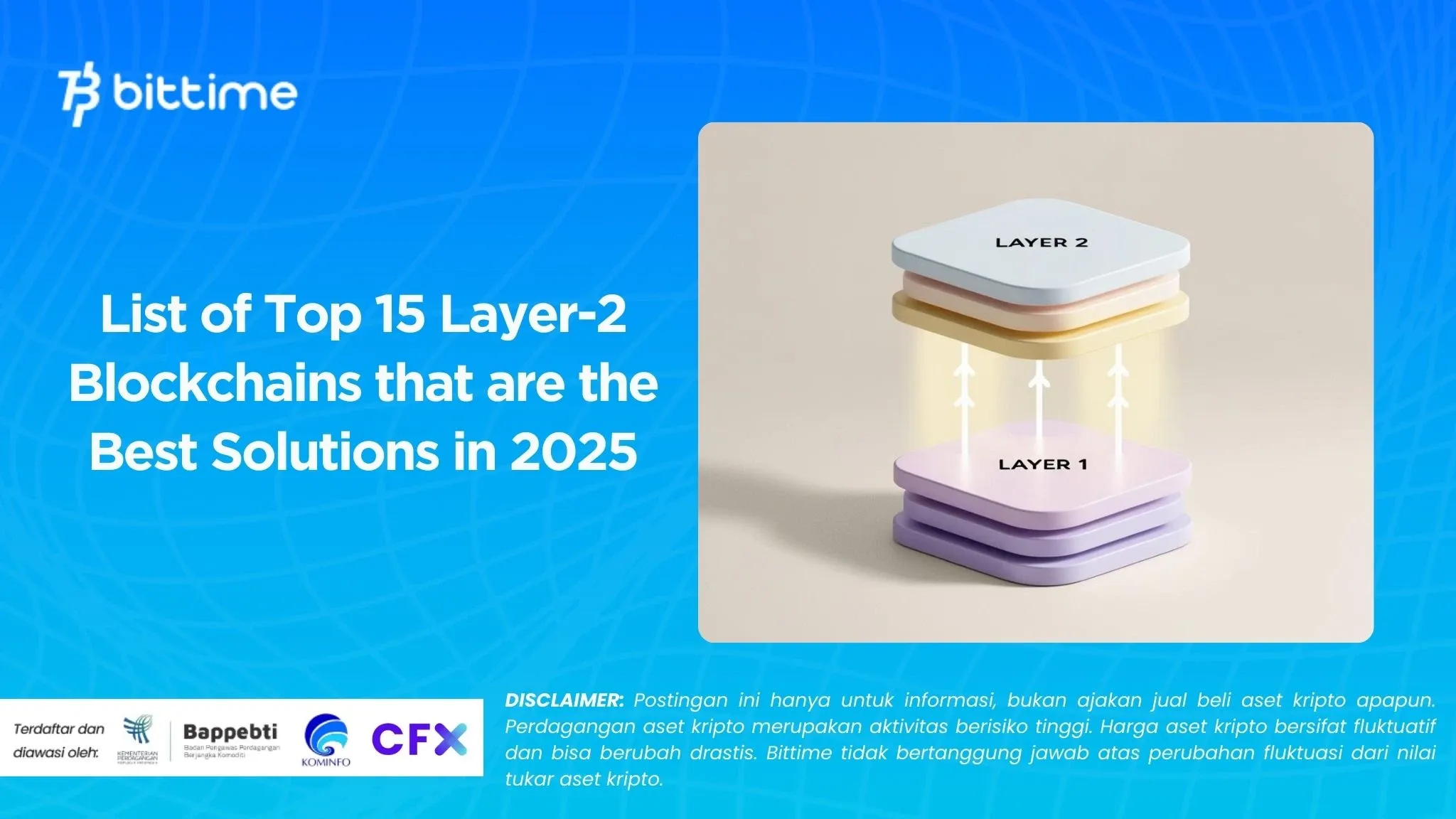
Bittime - Since it first appeared in 2008 as a decentralized payment system, technology blockchain it's grown really fast. Now, blockchain being the force behind many cool applications like DeFi, GameFi, NFT, metaverse, to Web3. But, with more and more people using it blockchain, one important issue arises: scalability.
Ethereum and Bitcoin indeed blockchain The main (Layer-1) is very important, but unfortunately their capabilities are limited. They are a bit slower when it comes to processing transactions compared to traditional systems. Bitcoin can only process around 7 transactions per second (TPS), while Ethereum Layer-1 is around 15 TPS (2025 data). This is really far compared to VISA which can reach 1,700 TPS.
So, in this article we will discuss how Layer-2 solutions can improve TPS blockchain, the most promising Layer-2 projects in 2025, and how they are trying to solve the problem blockchain trilemma.
What is Layer-2 Protocol in the Crypto World?
Simply put, a Layer-2 solution is like booster to improve performance and scalability blockchain Layer-1, for example Ethereum. This protocol works above blockchain main, so it can reduce network congestion, reduce transaction costs, and speed up the transaction process.
How Layer-2 Solutions Work
In principle, Layer-2 processes transactions outside blockchain main (off-chain). As a result, transactions that have been processed are summarized into just one transaction blockchain main. This method is very effective for reducing network congestion, processing time and transaction costs.
So, the transaction is redirected from blockchain primary and processed elsewhere. Just think of it like a toll road specifically for transactions. This makes it blockchain The main thing is there are no traffic jams, transactions are faster, costs are cheaper, and capacity increases.
Types of Layer-2 Solutions
This Layer-2 solution is like a shortcut for transactions, avoiding congestion on the network blockchain Layer-1. There are several types of Layer-2 solutions that are trending:
Optimistic Rollups
Optimistic Rollups are a popular solution for increasing Ethereum Layer-2 scalability. They assume all transactions are valid, unless someone proves otherwise. This makes verification costs cheaper and processing faster.
Zero-Knowledge Rollups (zk Rollups)
For zk Rollups, they combine many transactions into one proof (proof) so that privacy and efficiency increase. Its main features are better privacy and scalability. zk Rollups are also not too burdensome blockchain, that's why it is widely used in DeFi and NFT applications.
Ethereum Plasma Chains
Plasma chains are Ethereum's Layer-2 network which functions as sidechain specifically connected to the Ethereum main network. They offer faster transactions, lower fees, and a different approach than based solutions rollup.
Validium
Validium is a Layer-2 technology that moves transaction validation externally blockchain. This ensures security via cryptographic proof without sacrificing scalability. Very suitable for applications that require high speed and capacity.
Top 15 Layer-2 Networks with the Best Performance
This Layer-2 solution is very important to speed up transactions blockchain. Come on, let's look at some protocols blockchain leading people who use this technology to make it more efficient and scalable.
List of Top 15 Layer-2 Blockchains that are the Best Solutions in 2025
1. MetaverseX
MetaverseX is an innovative project that leverages zk-Rollups technology to increase transaction efficiency in the virtual world and metaverse. With a based approach blockchain, MetaverseX delivers an immersive experience for users, enabling them to create, build, and trade digital assets in a rich virtual environment. This project is designed to drive a revolution in the metaverse world by integrating advanced technologies and based economic models Play-To-Earn.
MetaverseX focuses on creating a completely decentralized ecosystem, where players can design their own virtual worlds without the constraints of pre-existing structures.
MetaverseX zk-Rollups
By utilizing zk-Rollups technology, transactions on this platform are faster, safer and cost-effective. Players can also create and trade Non-Fungible Tokens (NFT) as unique digital assets that have real economic value. This feature not only enriches the gaming experience, but also opens up monetization opportunities for users.
The economy in MetaverseX is powered by a native token called $METAX, which is used for various activities on the platform, such as buying digital assets, staking, to participation in community governance. Model Play-To-Earn allowing players to earn rewards in the form of tokens when they interact and contribute to the ecosystem. This creates financial incentives that encourage active engagement from the user community.
Smart Contracts MetaverseX
Additionally, MetaverseX uses smart contracts (smart contracts) as the backbone of its operations. This technology ensures that all transactions, such as NFT creation, asset trading, and game prize distribution, take place transparently and automatically without third party interference. This approach increases users' trust in the system while ensuring the security of their digital assets.
MetaverseX Projection
As a project that is still developing, MetaverseX shows great potential to change the landscape of gaming and virtual worlds as a whole. With a combination of zk-Rollups technology, a blockchain-based economic model, and a focus on decentralization and user creativity, MetaverseX not only offers a unique gaming experience but also paves the way for a new era of digital interaction. The $METAX token became a symbol of the project's grand vision: creating a virtual world where creativity meets real economic opportunities.
2. Mantle
Mantle Network is an L2 technology designed to scale Ethereum. This is the first major product from the Mantle Ecosystem and is committed to being compatible with the Ethereum Virtual Machine. Its modular architecture separates transaction execution, data availability, and transaction finality into separate modules. This allows for easy upgrades and implementation of the latest innovations.
Token Mantle (MNT)
As the world's first DAO-based L2, Mantle Network is leading the way towards widespread adoption of token-governed technology. Mantle Network's native token, MNT, is used to pay gas fees, develop the ecosystem, and govern the network through community participation.
Read too Mantle Distributes EIGEN Airdrop to USDe Holders in Pendle
3. Orderly Network
Orderly Network (ORDER) is a Layer 2 solution that builds on top of the OP stack, creating layers permisionless to use liquidity in Web3 trading. This setup enables shared order books across blockchains such as Arbitrum, Optimism, Polygon, Base, Mantle, and Near, with plans to include more in the future.
Read too Upgrade is Complete, Here Are 5 New Features of Orderly Network!
Facilitates Interaction Between Networks
The goal of the network is to make trading easier across any chain, asset, or interface, making it a key player in DeFi. One of the main features of Orderly Network is its support for building decentralized exchanges (DEX). By using a shared order book, developers can create DEXs that offer good exchange rates and work well with various decentralized applications (dApps) and trading bots. This is very useful for brokers, wallets and custodians who want to improve their services.
4. Arbitrum
Arbitrum is a developer-friendly Layer-2 Ethereum network with throughput peak 4,000 TPS. That is, Arbitrum is 10 times faster than mainnet Ethereum and can reduce gas fees by up to 95%. As of January 2025, Arbitrum controls over 51% market share among Ethereum Layer-2 networks in terms of TVL (Total Value Locked). There are also many DeFi protocols here, marketplace NFTs, and platform game.
Read too Cara Member Arbitrum (ARB)
The ARB token has many functions, including making transaction fees, staking, and network governance. As an L2 solution, Arbitrum relies on security mainnet Ethereum. Despite the risks associated with its recent launch, Arbitrum is growing in popularity and becoming a key player in the L2 world thanks to its strong development team and community.
5. Polygon
Polygon is an ecosystem multichain which offers a Layer-2 solution to scale Ethereum with faster transactions and cheaper gas fees. It includes zkRollups and a Proof-of-Stake consensus mechanism. The original token, MATIC, is used for gas fees, staking, and network governance.
Polygon Speed
Throughput Polygon can have more than 65,000 TPS, very suitable for DeFi applications and marketplace NFT because the transaction fees are cheap. Polygon is easy to integrate with Ethereum and blockchain other. Popular DeFi protocols like Aave, SushiSwap, and Curve operate in its fast-growing ecosystem. Marketplace Top NFTs like OpenSea and Rarible also use Polygon solutions. Its easy-to-use developer tools attract innovative projects and have one of the highest DeFi TVLs among Layer-2 networks.
6. Optimism
By utilizing Optimistic Rollups, Optimism offers the security and reliability of Ethereum without scalability issues. Optimism can handle throughput peak 4,000 TPS, processing transactions 26 times faster than mainnet Ethereum. Apart from that, gas costs can also be cut by up to 90%.
Read too How to Buy Optimism (OP)
The Optimism Community is committed to making it happen self-governing and provides various DeFi protocols, marketplace NFTs, and DAOs. Optimism also offers a developer-friendly environment with easy-to-access tools and a collaborative community.
Token Optimism (OP)
OP's native token has many uses: transaction fees, staking, and network governance. It is also important to remember when using it mainnet Ethereum by Optimism has its own risks, and its decentralization process requires constant monitoring. But, Optimism's dedicated team and active community continue to improve its technology and ecosystem, making it a leader in the Layer-2 world.
7. Base
Coinbase developed a Layer-2 protocol called Base to increase Ethereum's potential by speeding up transactions and reducing fees. Base uses OP Stack and Optimistic Rollups to achieve throughput 2,000 TPS and promises almost instant transactions. The goal is to reduce Ethereum gas fees by 95%, making it more affordable for DeFi and NFT activities.
Base Claimed to be Developer Friendly
Base is platform which is developer friendly and guarantees asset security through processing off-chain while leveraging the security of Ethereum. Base is worth paying attention to as it continues to evolve as a Layer-2 solution that focuses on speed, affordability, and ease for developers.
8. Immutable X
Immutable X is a Layer-2 network that enhances the experience gaming Web3. This network is fast, affordable, and secure, enabling more than 4,000 TPS at minimal cost. Immutable X powered by the IMX token, which makes it possible staking, participation in governance, and payment of fees.
Read too How to Buy Immutable (IMX)
Player game benefit from fast transactions, true NFT ownership, and interoperability game. Meanwhile, developers can enjoy low costs, easy-to-use tools, and a supportive community. ImmutableX is blockchain Layer-2 Ethereum is popular for NFTs with throughput high and significant market share.
9. Myria
Myria is an L2 solution designed to improve Ethereum performance, especially for NFTs and blockchain gaming. Myria works with StarkWare to provide fast trade confirmations and no gas fees minting and trade NFTs, while keeping user assets safe. Layer 2 Myria use STRONG samples from StarkWare and Zero-Knowledge Rollup (ZK-Rollup) technology. This allows Myria to combine multiple transfers into one transaction, handling up to 9,000 transactions per second (TPS).
Myria Speed and Security
By creating a Layer 2 that connects directly to Ethereum, rather than functioning as sidechain separately, Myria can meet high performance needs while allowing users to benefit from the trusted security of Ethereum.
10. zkSync Era
zkSync Era is a Layer-2 protocol designed to improve Ethereum's performance using technology zero-knowledge advanced. The goal is not only to accelerate Ethereum, but also to maintain its core values: freedom, self-sovereignty, and decentralization. This Layer-2 solution speeds up transactions and lowers fees, addressing two major problems facing Ethereum.
Different with method scaling other, zkSync maintaining Ethereum's core values even as Ethereum grows.
Batch Processing zkSync
Zero-knowledge rollups combine several transactions into one batch, which is processed outside the Ethereum main network. This reduces Ethereum's workload, resulting in faster and cheaper transactions. This protocol design ensures that data integrity and security remain strong even as the number of transactions increases.
11. Metis: Next Generation L2 Solution for DAC and DeFi
put is a next-generation Layer-2 solution designed to simplify the development of decentralized autonomous enterprises (DAC). By combining Optimistic Rollups technology and intuitive developer tools, put offers low-cost transactions, high speed, and ease of use. This makes it one of the best Layer-2 solutions for DeFi and NFTs.
Read too How to Buy MetisDAO (METIS)
Metis Optimstic Rollups
Metis uses Optimistic Rollups, which enables reduced operational costs for DApps and DACs. Additionally, Metis improved throughput transactions to support scalable applications. Metis also provides the infrastructure to build and manage DACs, making them platform complete for decentralization needs.
Metis is very suitable for DeFi applications, because it can support decentralized financial services scalable. Apart from that, Metis also makes the process easier minting and NFT trading with lower fees. Some well-known projects built on Metis are Andromeda, a decentralized application network, and Agora, platform governance that leverages Metis' efficiency and scalability.
12. Boba Network: L2 Solution with Real World Data Integration
Boba Network extends the capabilities of Layer-2 solutions with features hybrid compute, which allows DApps to interact with APIs and dataset off-chain. This capability combines scalability with real-world data integration, placing it among the best Layer-2 solutions.
Boba Network uses Optimistic Rollups and hybrid compute to improve DApp functionality. This allows interaction with data and APIs off-chain, processes transactions quickly and affordably, and supports a variety of applications including machine learning and DeFi.
Boba Network has many uses, including integration machine learning, which empowers DApps to leverage the model machine learning off-chain. Additionally, Boba Network facilitates trading and minting Efficient NFTs, as well as enabling decentralized financial services scalable and cost effective. Notable projects leveraging Boba Network are Enya, a decentralized infrastructure project, and Tether integration for operations stablecoin efficient and scalable.
13. Loopring: zk-Rollup Based L2 Network for DEX
Loopring is a zk-Rollup based Layer-2 solution that improves Ethereum's scalability while maintaining its security. Loopring is known as one of the best Layer-2 solutions, with a focus on providing low-cost and high-speed transactions, especially for decentralized exchanges (DEX).
Loopring uses zk-Rollups and is optimized for DEXs, ensuring a seamless trading experience. Loopring drastically reduces gas fees for trading and transfers, and leverages zk-Rollup technology to process thousands of transactions per second off-chain without compromising security.
Read too How to Buy Loopering (LRC)
Loopring provides the infrastructure for fast, secure, and cost-effective trading, as well as support platform decentralized trading. One of the well-known projects on Loopring is Loopring Exchange, a leading DEX built on Loopring's zk-Rollup technology, enabling efficient and low-cost crypto trading.
14. Shibarium: Shiba Inu Ecosystem L2 Blockchain
Shibarium is blockchain Layer-2 developed in the Shiba Inu ecosystem. This is an important innovation in Layer-2 solutions, addressing the demand for transactions blockchain which is faster, more cost effective, and scalable. Built to complement Ethereum, Shibarium improves performance while reducing transaction costs, making it a strong contender among the best Layer-2 solutions.
Read too Shibarium Hard Fork: What Is It and Why Is It Important To The Shiba Inu Ecosystem?
Shibarium speeds up transaction processing for a seamless user experience, drastically reduces gas fees, and provides platform scalable to develop decentralized applications (DApps). Shibarium also encourages innovation through active community involvement.
Shibarium is efficient in handling small value transactions due to its low fees, increasing scalability for decentralized financial services, and providing minting and gas efficient NFT trading. In addition, Shibarium provides a seamless user experience for game based blockchain. Notable projects on Shibarium are ShibaSwap, an ecosystem DEX that benefits from Shibarium's speed and cost efficiency, as well as a SHIB-based ecosystem application that leverages Shibarium for better scalability and user engagement.
15. Starknet
Starknet uses STARK tokens to validate transactions off-chain, enabling millions of transactions per second. This reduces transaction costs, creates interaction blockchain almost no cost. Starknet has a developer-friendly environment, powerful tools, and a familiar programming language, Cairo. The goal is to be fully decentralized and host a rapidly growing ecosystem of innovative dApps across DeFi, NFT, gaming, and many more.
Read too How to Buy Starknet (STRK)
Although the cryptographic nature of Starknet may seem intimidating to newcomers, it is important to note that platform it is still in the development stage, and its user base is smaller than more established Layer-2 solutions. Because of this, users may need to adapt upgrade and potential changes in the future.
Conclusion
Protocol blockchain Layer-2 has become an important part in improving the ecosystem blockchain. By overcoming the limitations of Layer-1 protocols, they play an important role in making transactions faster, more cost-effective, and scalable.
These Layer-2 networks represent a transformative phase in the evolution of technology blockchain. They are not just trends, but major changes that are shaping the future of the crypto industry. Starting from the rapidly growing Ethereum L2 project to solutions scaling Bitcoin's innovative network paved the way for wider adoption, opening up new opportunities.
They prove that blockchain it can be fast, affordable, and easily accessible to everyone, making it a promising technology for the future.
FAQ about Layer-2 Blockchain
What is Layer-2 Blockchain?
Layer-2 blockchain is a solution built on top of the main blockchain (Layer-1) to increase scalability and transaction efficiency. By processing transactions outside chain Mainly, Layer-2 enables reduced transaction costs and increased speed without compromising the security provided by the underlying blockchain.
How does Layer-2 work to increase transaction efficiency?
Layer-2 works by offloading most of the transaction processing to off-chain, which means transactions are carried out outside the main network. Once processing is complete, the results are returned to Layer-1 for validation and final completion. This helps reduce congestion on the main network and improves overall throughput.
What are the popular types of Layer-2 solutions?
Some commonly used types of Layer-2 solutions include:
Optimistic Rollups: Assumes all transactions are valid unless there is evidence to the contrary, enabling fast processing with low fees.
Zero-Knowledge Rollups (zk-Rollups): Combine multiple transactions into a single token, maintaining privacy and security while increasing efficiency.
Plasma Chains: Build child chains which can handle large transaction volumes independently before sending the results back to the main blockchain.
Is Layer-2 Blockchain safe?
Yes, Layer-2 blockchain inherits security from the main blockchain (Layer-1). Even though transactions are processed automatically off-chain, the final outcome is resolved at Layer-1, which guarantees the integrity and reliability of transactions through the consensus mechanism and immutability of the underlying blockchain.
How is the interoperability between Layer-1 and Layer-2?
Layer-2 is designed to be able to interact with Layer-1. They can open and close state channels, post grouped transactions, or transfer assets between chains. This interoperability allows users to leverage the security of Layer-1 while enjoying the increased efficiency of Layer-2 solutions.
What impact will using Layer-2 have on transaction costs?
By using Layer-2 solutions, transaction costs can be reduced significantly. Since most of the processing is done outside the main network, the load on Layer-1 is reduced, so users can enjoy lower fees and a faster transaction experience.
How to Buy Crypto on Bittime
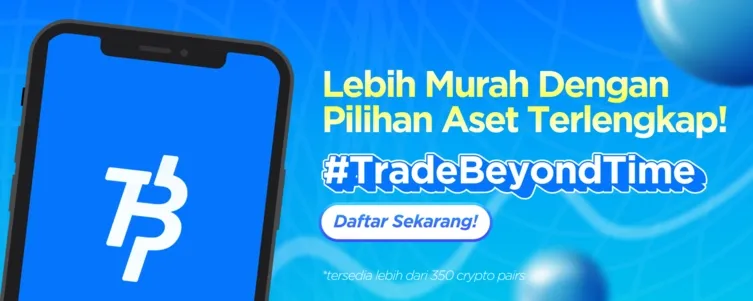
Want to trade sell buy Bitcoins and crypto investment easily? Bittime is here to help! As an Indonesian crypto exchange officially registered with Bappebti, Bittime ensures every transaction is safe and fast.
Start with registration and identity verification, then make a minimum deposit of IDR 10,000. After that, you can immediately buy your favorite digital assets!
Check the exchange rate BTC to IDR, ETH to IDR, SOL to IDR and other crypto assets to find out today's crypto market trends in real-time on Bittime.
Also, visit the Bittime Blog for interesting updates and educational information about the crypto world. Find reliable articles about Web3, blockchain technology, and digital asset investment tips designed to enrich your crypto knowledge.
Reference
Antiersolutions, Top 10 Layer 2 Scaling Solutions You Should Invest in by 2025, Accessed March 6, 2025
Tangem team, Top 10 Layer-2 Crypto Projects in 2025, Accessed March 6, 2025
Author: IN
Disclaimer: The views expressed belong exclusively to the author and do not reflect the views of this platform. This platform and its affiliates disclaim any responsibility for the accuracy or suitability of the information provided. It is for informational purposes only and not intended as financial or investment advice.

